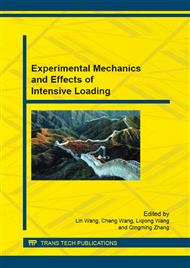[1]
G. Malakondaiah, M. Srinivas, P.R. Rao, Ultrahigh-strength low-alloy steels with enhanced fracture toughness, Progress in Materials Science, 42 (1997) 209-242.
DOI: 10.1016/s0079-6425(97)00016-9
Google Scholar
[2]
W.M. Garrison Jr, J. L Maloney, Lanthanum additions and the toughness of ultra-high strength steels and the determination of appropriate lanthanum additions, Materials Science and Engineering: A, 403 (2005) 299-310.
DOI: 10.1016/j.msea.2005.05.021
Google Scholar
[3]
T. Mukai, K. Ishikawa, K. Higashi, Influence of strain rate on the mechanical properties in fine-grained aluminum alloys, Materials Science and Engineering: A, 204 (2005) 12-18.
DOI: 10.1016/0921-5093(95)09929-8
Google Scholar
[4]
S. Yadav, K.T. Ramesh, The Mechanical Properties of Tungsten-Based Composites at Very High Strain Rates, Materials Science and Engineering: A, 203 (1995) 140-153.
DOI: 10.1016/0921-5093(95)09865-8
Google Scholar
[5]
S. Belyaev, A. Petrov, A. Razov, Mechanical Properties of Titanium Nickelide at High Strain Rate Loading, Materials Science and Engineering: A, 378 (2004) 122-124.
DOI: 10.1016/j.msea.2003.11.059
Google Scholar
[6]
Y. L Gong, C. E Wen, X. X Wu, The Influence of Strain Rate, Deformation Temperature and Stacking Fault Energy on the Mechanical Properties of Cu Alloys, Materials Science and Engineering: A, 583 (2013) 199-204.
DOI: 10.1016/j.msea.2013.07.001
Google Scholar
[7]
S. Nemat-Nasser, W. G. Guo, Thermomechanical Response of Dh-36 Structural Steel over a Wide Range of Strain Rates and Temperatures, Mechanics of Materials, 35 (2003) 1023-1047.
DOI: 10.1016/s0167-6636(02)00323-x
Google Scholar
[8]
M. G daSilva, K. T Ramesh, The Rate-Dependent Deformation and Localization of Fully Dense and Porous Ti-6al-4v, Materials Science and Engineering a-Structural Materials Properties Microstructure and Processing, 232 (1997) 11-22.
DOI: 10.1016/s0921-5093(97)00076-2
Google Scholar
[9]
W.S. Lee, T.T. Su, Mechanical Properties and Microstructural Features of Aisi 4340 High-Strength Alloy Steel under Quenched and Tempered Conditions, Journal of Materials Processing Technology, 87 (1999) 198-206.
DOI: 10.1016/s0924-0136(98)00351-3
Google Scholar
[10]
P. S Follansbee, U. F Kocks, A Constitutive Description of the Deformation of Copper Based on the Use of the Mechanical Threshold Stress as an Internal State Variable, Acta Metallurgical, 36 (1988) 81-93.
DOI: 10.1016/0001-6160(88)90030-2
Google Scholar
[11]
F. Zerilli, R. Armstrong, The Effect of Dislocation Drag on the Stress-Strain Behavior of Fcc Metals, Acta Metallurgica et Materialia, 40 (1992) 1803-1808.
DOI: 10.1016/0956-7151(92)90166-c
Google Scholar
[12]
Q. Li, Y. B Xu, Z.H. Lai, Dynamic Recrystallization Induced by Plastic Deformation at High Strain Rate in a Monel Alloy, Materials Science and Engineering a-Structural Materials Properties Microstructure and Processing, 276 (2000) 250-256.
DOI: 10.1016/s0921-5093(99)00127-6
Google Scholar
[13]
L.E. Murr, A.C. Ramirez, S.M. Gaytan, Microstructure Evolution Associated with Adiabatic Shear Bands and Shear Band Failure in Ballistic Plug Formation in Ti–6al–4v Targets, Materials Science and Engineering: A, 516 (2009) 205-216.
DOI: 10.1016/j.msea.2009.03.051
Google Scholar
[14]
D. Rittel, S. Osovski, Dynamic Failure by Adiabatic Shear Banding, International Journal of Fracture, 162 (2010) 177-185.
DOI: 10.1007/s10704-010-9475-8
Google Scholar
[15]
P. Landau, A. Venkert, D. Rittel, Microstructural Aspects of Adiabatic Shear Failure in Annealed Ti6al4v, Metallurgical and Materials Transactions A, 41 (2010) 389-396.
DOI: 10.1007/s11661-009-0098-5
Google Scholar
[16]
S. Zhao, X. Cheng, S. Li, Effect of Austenitising Temperature on Microstructure and Mechanical Properties of an Ultrahigh Strength High Alloy G33 Steel, Materials Research Innovations. 17 (2013) s277-s281.
DOI: 10.1179/1432891713z.000000000230
Google Scholar
[17]
C. Zener, J.H. Hollomon, Effect of Strain Rate Upon Plastic Flow of Steel, Journal of Applied Physics, 15 (1944) 22-32.
DOI: 10.1063/1.1707363
Google Scholar
[18]
C. J D, D.A. R. J, The Behavior of Materials Subjected to Dynamic Incremental Shear Loading, Mech. Phys. Solids, 18 (1970) 21.
Google Scholar
[19]
K. Hoge, A. Mukherjee, The Temperature and Strain Rate Dependence of the Flow Stress of Tantalum, Journal of Materials Science, 12 (1977) 1666-1672.
DOI: 10.1007/bf00542818
Google Scholar
[20]
R W. Cahn, Recrystallization of Metallic Materials, Riederer, Stuttgart, (1971).
Google Scholar
[21]
A.G. Odeshi, M.N. Bassim, S. Al-Ameeri, Dynamic Shear Band Propagation and Failure in Aisi 4340 Steel, Journal of Materials Processing Technology, 169 (2005) 150-155.
DOI: 10.1016/j.jmatprotec.2005.03.016
Google Scholar
[22]
Y. Xu, J. Zhang, Y. Bai, Shear Localization in Dynamic Deformation: Microstructural Evolution, Metallurgical and Materials Transactions A, 39 (2008) 811-843.
DOI: 10.1007/s11661-007-9431-z
Google Scholar
[23]
J.F.C. Lins, H.R.Z. Sandim, H.J. Kestenbach, A Microstructural Investigation of Adiabatic Shear Bands in an Interstitial Free Steel, Materials Science and Engineering: A, 457 (2007) 205-218.
DOI: 10.1016/j.msea.2006.12.019
Google Scholar


